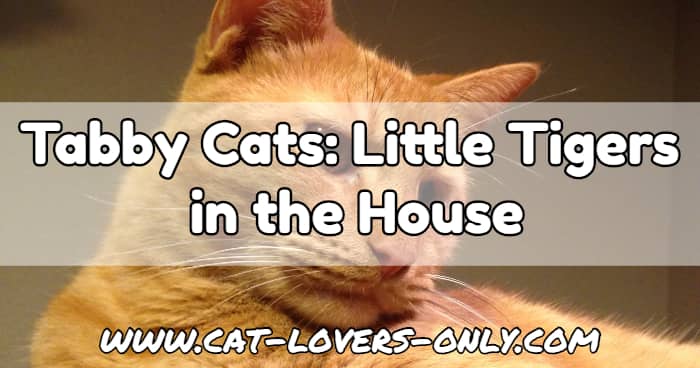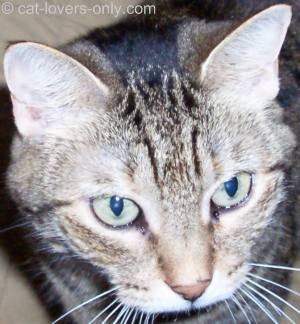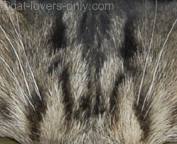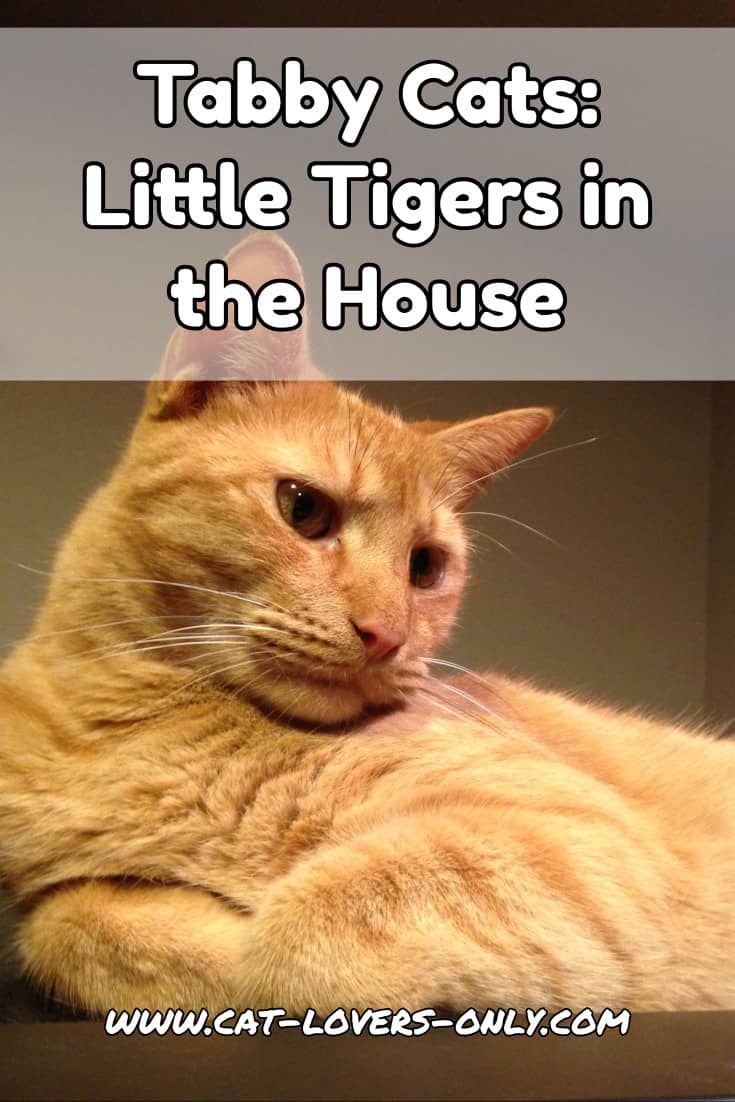Tabby Cats: Little Tigers in the House
Tabby cats are instantly recognizable, of course, with their spots and stripes.
They're so common that many people instantly think of them when the word cat comes up.
Many people think of them as a breed, but this is not the case.

Tabbies are very popular as pet cats, and hence the popularity of the name Tiger as a male cat name. That of course, and Tigger, the famous cartoon cat from the Winnie the Pooh stories.
Tigger and Tiger are often number one and number two, respectively, as the overall most popular cat names in the US.
These two classic tabby cats in the video below are having a mutual grooming session, which often turns into play fighting. This is a behavior often seen in kittens and adult cats as well.
Types of Tabby Cats
 Priscilla has the tabby "M" marking on her forehead, although hers is not as well defined as some and is more like the scarab pattern.
Priscilla has the tabby "M" marking on her forehead, although hers is not as well defined as some and is more like the scarab pattern.Contrary to what some people assume, the term tabby does not refer to a breed, but a coat pattern.
While this pattern may show up in some breeds, it is also often seen in non-purebred cats (moggies) as well.
The genetics involved with cat coat color and patterns are somewhat complex, and there are a number of distinct tabby patterns.
Since coat color and coat patterns are not interdependent, tabby cats can actually be any color.
They can also appear in combination, for example, with white in various areas of the body.
There are also tortoiseshell tabbies, called torbies, and calico (tortoiseshell and white) sometimes referred to as torbie and white. These are collectively referred to as "patched tabby."
Tabby Markings

There are four different tabby patterns (mackerel, spotted, ticked, and classic). These may be in any of the tabby colors.
- Mackerel - The aptly named mackerel (or fishbone) pattern is essentially striped. It's characterized by vertical stripes down the sides of the cat's body. By definition, these stripes are relatively thin (as opposed to the thicker stripes of the classic). The stripes may be broken up into separate bars or spots. Tails are ringed, legs have bracelets, and the chest wears necklaces. This is the most common of the tabby patterns.
- Spotted - The Egyptian Mau and the Ocicat are spotted tabby cats. There are both large spot and small spot coat patterns. There are distinct differences, when discussing breed profiles and standards, between a mackerel pattern with broken up stripes, and the spotted pattern.
- Ticked - The Agouti, or ticked pattern appears on many tabby cats. Each individual hair will have bands of color. If this occurs evenly and the coat is ticked all over as on the Abyssinian, then the tabby pattern takes on a salt-and-pepper appearance rather than the distinct markings of bars, rings, or spots. Sometimes, however, ghost stripes can be seen on the face, belly, legs, and tail.
- Classic - The classic or blotched tabby has a swirled or whorled pattern with much wider stripes than the mackerel. It has "butterfly" patterns on the shoulders, and usually a bullseye or oyster pattern on the flank, with encircled rings. The legs and tail are barred with rings of varying thickness.
Depending upon the type of tabby pattern, the markings may be described in different ways. In breed profiles, various terms are used to describe the markings as ringed or barred, blotched, and spotted.
Here's an excerpt from the CFA breed profile for the Norwegian Forest cat, describing the classic pattern:
CLASSIC TABBY PATTERN: markings dense, clearly defined, and broad. Legs evenly barred with bracelets coming up to meet the body markings. Tail evenly ringed. Several necklaces on neck and upper chest, with locket allowed. Frown marks on forehead form an intricate letter “M.” Unbroken line runs back from outer corner of eye. Swirls on cheeks. Vertical lines over back of head extend to shoulder markings which are in the shape of a butterfly with both upper and lower wings distinctly outlined and marked with dots inside outline. Back markings consist of a vertical line down the spine from butterfly to tail with a vertical stripe paralleling it on each side, the three stripes separated by stripes of the ground color. Large solid blotch on each side to be encircled by one or more unbroken rings. Side markings should be the same on both sides. Double vertical rows of buttons on chest and stomach. White buttons and/or lockets allowed.
Tabby Breeds
Tabby cats can appear in many breeds. Some of these will be accepted by the various registries of the cat fancy for pedigreed registration and showing, but not all will.
So, cats of certain breeds that have tabby markings can't be shown, and are therefore pet quality. If you'd like a pet of a particular breed, but aren't interested in showing your cat, this can be a great opportunity.
You can get a purebred pet cat at a reduced price from what you would have to pay for a show quality cat. Simply contact some breeders and ask them about pet quality cats.
Make sure you thoroughly check out the breeder before you buy. Before doing any of that, however, you might want to look into getting your tabby cat from shelters, rescue groups, or pure breed rescues.
Some of the tabby cat breeds the CFA recognizes are:
- American Shorthair - As the name implies, the American Shorthair has a short, sleek coat that is low maintenance.
- Colorpoint Shorthair - Colorpoint Shorthairs are the more colorful cousins of the Siamese cat breed. The CFA recognizes certain tabby pointed cats in this breed. (Siamese cats are not permitted in tabby in the CFA). These tabbies are called lynx points. The lynx point class of Colorpoint Shorthairs is made up of (my three favorites) the chocolate-lynx points, lilac-lynx points, and seal-lynx points. This class also includes cream lynx-points, red-lynx points, and blue-lynx points.
- Maine Coon - If you're looking for a large, majestic longhair, Maine Coons are right up your alley. They can be found in a variety of tabby patterns and colors.
- Norwegian Forest Cat - Another large cat with long hair, the NWFC is a fan favorite of many.
- Persian - Tabby Persians can be quite striking looking. Some of the color combinations are difficult to achieve, and this again can be an opportunity for you to get a pet quality purebred. If you don't mind a silver tabby Persian (if you can find one at all) with orange eyes, you can get yourself a pet quality Persian.
Topics Related to Tabby Cats
These books on cat breeds contain information on various coat colors and patterns



Comments: What do you think?
Have your say about what you just read. Leave me a comment in the box below.